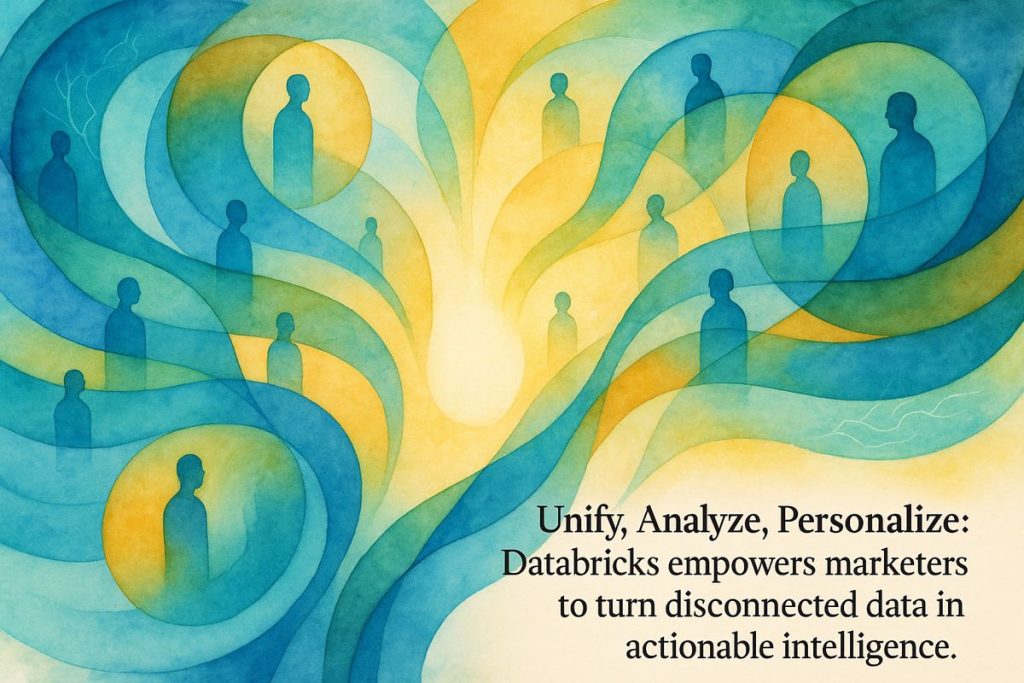Databricks Data Intelligence for Marketing is like a super-organized control room for all your scattered marketing data, bringing everything together in one place. It lets marketers get instant answers, create smart campaigns, and personalize messages with the help of AI, all without needing tech support. The platform feels fast and easy, turning messy data chaos into clear, usable insights in just a few clicks. It’s built to work for all kinds of businesses, from pharma to retail, making marketing smoother, smarter, and ready for the future.
What is Databricks Data Intelligence for Marketing and how does it benefit marketers?
Databricks Data Intelligence for Marketing is a unified platform that consolidates marketing data from multiple sources, provides real-time analytics, and leverages AI for audience segmentation and campaign automation. Marketers gain self-service insights, enhanced personalization, regulatory compliance, and seamless integration with leading martech tools—all in one solution.
The Data Labyrinth: Why Marketers Need a Map
Let’s set the scene. You’re a marketing lead at a global pharma company, and your team’s data is scattered across more platforms than you have tabs open after a triple espresso—Salesforce here, Tealium there, a pinch of Braze for good measure. Every week, you chase down numbers like a basset hound on a scent, only to realize half your “insights” are outdated or duplicated. Enter Databricks Data Intelligence for Marketing, a solution engineered to corral these digital cats into a single, well-lit room.
Built atop the celebrated Databricks Data Intelligence Platform, this isn’t just another marketing dashboard. It’s the computational equivalent of replacing your rickety filing cabinet with a hyperspectral scanner—suddenly, everything’s visible in real time. The secret sauce? Lakehouse architecture, a hybrid that fuses the scale of data lakes with the orderliness of data warehouses. I’ll admit, when I first heard “lakehouse,” I pictured a cozy cottage by Baikal; the reality is a smidge less scenic, but infinitely more useful.
What struck me isn’t just the architecture (though, as someone who once tried piecing together campaign reports from eight different CSVs, I nearly wept with relief at the demo), but the philosophy: your data, unified—not as a palimpsest of past efforts, but as a living map of every click, impression, and conversion.
Analytics Without the Wait: Power to the Marketer
Gone are the days when you needed a sacred pilgrimage to the IT desk for every insight. Databricks hands marketers the keys to their own data Ferrari. With real-time, self-service analytics, even campaign managers who haven’t coded since high school can slice and dice data with a few conversational queries. I mean, who hasn’t dreamed of asking, “Which HCPs clicked twice in Q2?” and actually getting an answer—without a two-week ticket?
The natural language querying is not just a gimmick—it’s democratization. Picture a strategist in the throes of campaign optimization, typing questions the way they’d speak in a meeting. The platform returns answers faster than a barista can steam oat milk. There’s a certain satisfaction (tinged with disbelief) in seeing a colleague with no SQL skills generate a predictive report on-the-fly. I had to stop and ask myself: is this what empowerment tastes like? Or is that just my fifth coffee talking?
Sensory detail? The interface hums with clean lines, the kind of UI that makes you want to touch your screen just to see if it’s real. There’s a faint tingle—anticipation, maybe—when you realize you can finally iterate campaigns without waiting for the analytics bottleneck to unclog.
AI and Automation: Your New Campaign Wingman
Here’s where the magic goes from sleight-of-hand to full-on prestidigitation. Databricks’ AI models segment audiences with the precision of a neurosurgeon wielding a diamond scalpel. Personalization? Automated. Content recommendations? Dynamically optimized. If you’re in pharma or life sciences, this matters—imagine tailoring outreach to HCPs and patients while threading the regulatory needle with GDPR and HIPAA as your somewhat stern chaperones.
Automation pulses through the platform like the persistent whir of a distant server farm—easing the grind of manual segmentation and freeing up brain space for genuine creativity. The first time I let the AI handle a campaign trigger, I felt a pang of anxiety (I’m a bit of a control enthusiast); the result? Higher engagement, no compliance headaches. Bam! Relief, tinged with humility: sometimes, the bot really does know best.
Databricks also integrates out-of-the-box with a who’s who of martech—Adobe, Amperity, Epsilon, Hightouch, and more. No custom connectors, no “it should just work” fiascos. Shoutout to Deloitte and Slalom for making the onboarding less of an ordeal and more of a guided tour.
Beyond Pharma: A Universal Swiss Army Knife
Sure, the launch trumpets its value to pharma and life sciences—where privacy laws loom large, and every customer touchpoint feels like navigating a minefield. But don’t let that fool you. Retailers, banks, and media empires are already riding this data juggernaut, unifying their martech stacks and wringing more ROI from every dollar.
I remember a micro-story from last quarter: a retail client, notorious for dusty legacy systems, plugged Databricks in and within a week had a single, shimmering customer profile spanning ten years and fourteen devices. The CMO’s reaction? “Ugh, why didn’t we do this sooner?” I felt a mix of amusement and, honestly, a twinge of envy. (We all want our data ducks in a row.)
The stakes are high. Marketers today must balance privacy, agility, and the hunger for hyper-personalization. Databricks’ open standards mean you’re not boxed in—no vendor handcuffs, just interoperability and future-proofing, which is rarer than a quiet Slack channel on launch day.
The Takeaway: Marketing, Unfragmented
If you crave more—case studies, official statements, digital confetti—here’s the press release, the official solution page.
